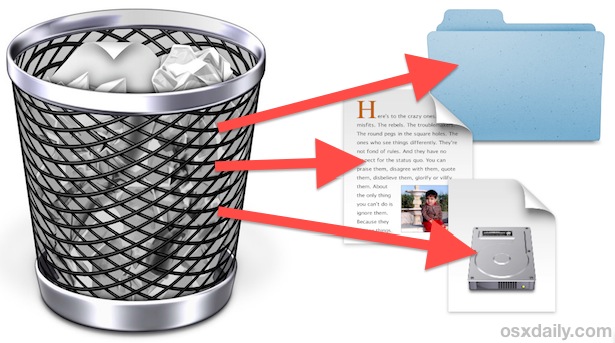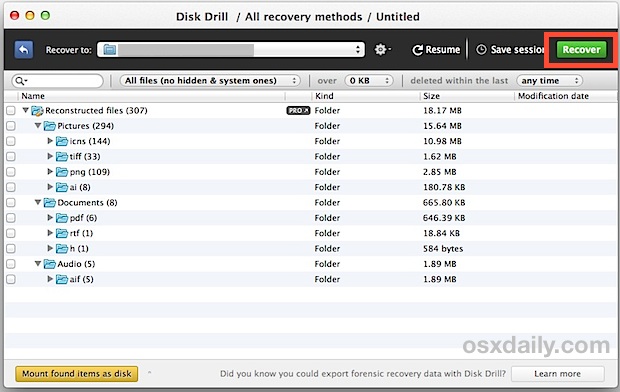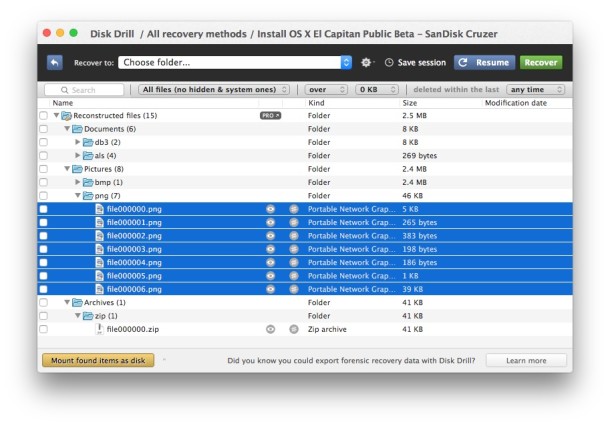Recover Deleted Files from Mac with DiskDrill

Did you remove a file or folder from your Mac drive or an external drive, and now you need it back? Don’t freak out yet because there is some potentially good news; you may be able to recover the deleted files from the Mac with the help of a third party tool called DiskDrill.
It’s not a miracle worker, but if the file(s) or folders you need to recover are not backed up, or were deleted from a back up drive, then DiskDrill offers an excellent choice for potential recovery. The initial version of DiskDrill is a free version that will scan both internal drives and external drives of any type to see if it can recover files that have been removed. You will have to pay to upgrade to the full Pro version to actually recover the files, but because DiskDrill has free scanning it basically means you’ll only pay if it can actually get your files back. Not a bad deal, right?
How to Recover Deleted Files & Folders from a Mac with DiskDrill
Here’s how DiskDrill file recovery works for macOS and Mac OS X:
- Get DiskDrill – choose the free download version to scan initially, no need to buy something if it doesn’t work for you right?
- If the drive to recover files from is external, connect it to the Mac now
- Launch DiskDrill, select the hard drive to recover files from and choose “Scan” – the scan process can take several minutes or several hours, depending on the drive type, the drive speed, the drive size, and the amount of files that can potentially be recovered
- When scanning is complete, locate the files to recover, set a recovery location (a new folder on the desktop makes it easy to find), and then choose the “Recover” option (this will require the Pro version, which costs $90 or so)
- Let DiskDrill recover the file(s) in question, which will appear in the specified directory as they are restored

DiskDrill breaks recoverable files down into format types and it has simple search features for file types, specific names, file size, and deletion date. Use those search tools to quickly narrow down results, or navigate through the folders of items found in the Disk Drill application to be able to see which files are recoverable. You can even preview files to be certain they are what you are looking to recover before buying the full version.
And by the way, Disk Drill even works to scan and recover files off external drives and volumes, whether it’s an external hard drive or an external USB flash drive. In the screen shot example below, an external USB flash drive has been scanned to recover files from, and it’s able to recover files from the flash disk that existed prior to the volume being formatted! That’s pretty cool, and demonstrates how impressive this app can be for data recovery:

How effective DiskDrill is ultimately depends on several factors, ranging from the time since initial file deletion, drive type (traditional hard drives are much easier to get deleted files from, flash SSD drives are much harder if not impossible after a short amount of time due to TRIM functionality), and overall drive activity, since every new write to the the drive may end up overwriting previously deleted data. Because you can scan for free with the basic version of DiskDrill though, there’s little reason not to try it out even if you wind up not using it. Ultimately for the best results and for the best chance at recovering a deleted or erased file, you’re going to want to take quick action though.
By the way, if you or any other user erased the free space on the drive in question, you may be out of luck. Likewise, drives protected with FileVault encryption may have significantly more challenges when attempting to recover deleted files.
What if the Disk Drive is Failing?
Drive failures typically go beyond the standard methods of file restoration, and trying to undelete something from a failing drive will likely be challenging since you are working against physical or file system failure. Nonetheless, you can always try to recover data from a failing drive with simple file transfers and careful management of the drive, particularly if you catch the drive in its initial stages of failure.
The longer the drive is running failed, and the worse the condition though, the less likely the simple tricks will work, and you may need to wind up using professional data recovery services or apps. DiskDrill can sometimes work magic on failing drives too, but often you’ll need to rely on a solution that is designed specifically for such circumstances, be it an app like DiskWarrior or a pricier service.
Are there other methods to recover data from hard drives?
Other approaches may be available to recover data. This includes recovering data from a Time Machine backup, or another system backup.
There are also other third party apps out there to help with data recovery.
Finally, there are dedicated data recovery services, some of which use the apps we’ve already discussed, and some which have proprietary data recovery methods of their own that range in complexity and expense. How important the data is will likely determine how much you want to spend on the data recovery if the aforementioned approaches do not work.
Do you have another data recovery method? Share what works for you and your Mac in the comments.


Here is a list of best data recovery softwares that I have found:
1. uFlysoft
2. Recuva
3. Disk Drill
4. Glary Undelete
5. Panda Recovery
6. SoftPerfect File Recovery
7. EaseUs Data Recovery Software
i loved that data recovery software
its very good data recovery softwre
Recently I accidently formatted my Mac hard drive thinking that data on it is out of interest but now I came to know that I stored some office documents on it. So can your software recover my documents from hard drive?
Phew, this saved my *** after accidentally deleting something. Glad to know it’s so easy!